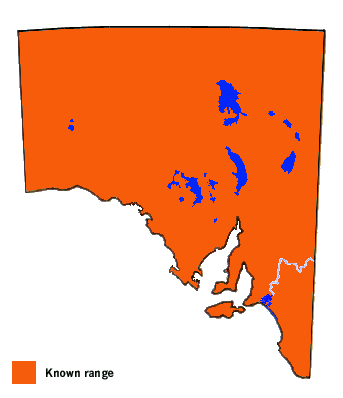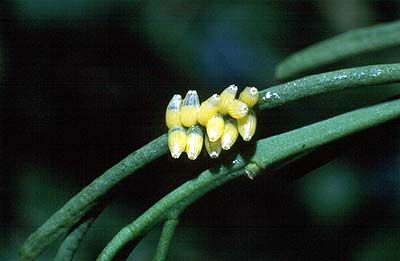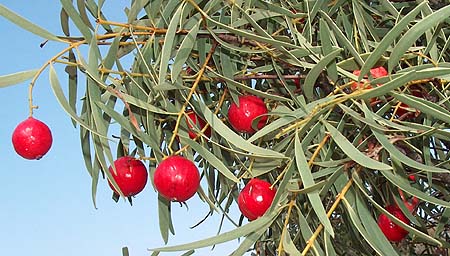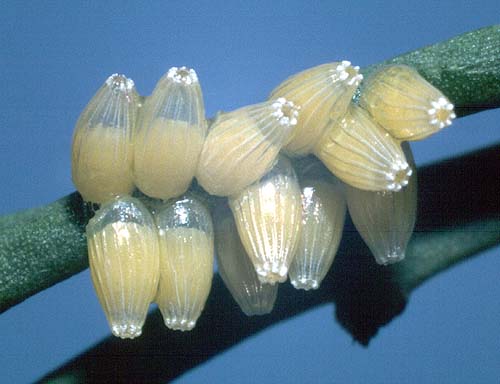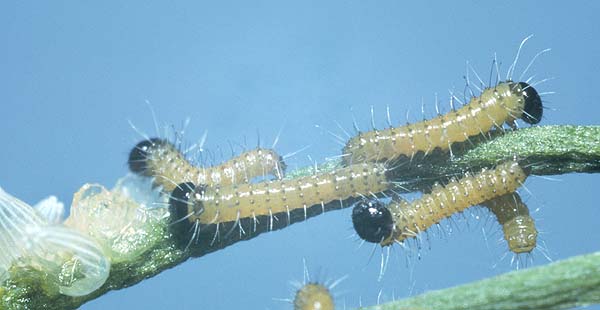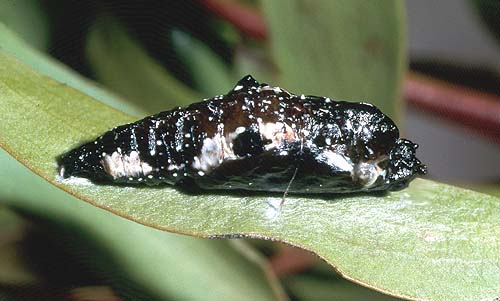Wood White
Delias aganippe (Donovan)

Interesting Aspects
This large, beautiful butterfly was once well established along the coastal areas of the Adelaide Plains, where colonies of the butterfly were present on quandong and the mistletoe Amyema melaleucae. It was one of the earliest butterflies to be recorded from South Australia by early European settlers. Its bright underside pattern is reminiscent of an artist's palette.
The butterfly belongs to a very large generic group of migratory butterflies (believed to number more than 170 individual species that are centred in Papua New Guinea-West Irian) within which the included butterflies and their early stages are poisonous to varying degrees, forming a Mullerian mimicry complex amongst themselves (mutualistic resemblance in which all the species are unpalatable). To a lesser extent, they also form poisonous models for other mimetic butterflies (Batesian mimicry), but not anywhere near to the same degree as occurs in the Heliconiids of the tropical Americas. The early stages remain exposed on the hostplants, and have characteristic shape and colour, and pupae colour markings, usually a bright yellow or orange warning (aposematic) colour. Members of the Delias generic group are well developed in the tropical Asia and Australian Regions and are closely related to similar Pierids in the tropical Americas and Africa that also have parasitic larval hostplants. Even though the Delias butterflies are centred in distribution within the tropics, they usually occur in cool elevated areas, and within Australia at least are also commonly encountered flying during the winter months.
The Delias butterflies obtain their toxic properties through their parasitic hostplants, and these toxins include butyric acids and polypeptides. The entire life history of these butterflies is poisonous, to varying degrees. Their hostplants contain poisons, which the larvae are able to assimilate and retain in their bodies as a protection against vertebrate predation. These toxins are then transferred via the pupae to the adult butterflies. The poisons are passed onto the eggs by the female to complete the cycle. These poisons are usually in sufficient concentrations to only sicken the vertebrate predators, so that they can both learn from the experience and pass on the knowledge. The poisons are not meant to cause death as this would likely result in larger numbers of the butterflies being predated.
The non-poisonous mimic butterflies gain protection from animal and bird predators due to their similarity to the poisonous model. To retain the non-predation protection the mimic butterflies have to remain in low numbers. In the case of the Mullerian complexes, if there are plentiful poisonous species of butterflies around then it does not become critical if some of them are critically maimed by predators, which usually spit the butterflies out once they have had a taste of the butterfly. The Delias advertise the presence of their body poisons with their aposematic warning colours, which are bright red and/or yellow spotting of the wing undersides, on a background colour of black and/or white. They often have a slow flight so that they can be easily recognised by bird predators, although when migrating their flight can be rapid and direct.
Delias aganippe has such a slow graceful gliding flight and the butterfly is readily visible in flight,but if disturbed can make off with great speed. However, Delias aganippe has a more unusual wing shape and morphology than other Delias, and along with its distinct early stages and the fact that it can tolerate hot arid conditions, is suggestive of an isolated position within the group, and perhaps a closer Gondwanaland origin with the South American mistletoe eating Pierid species. Its pupae mimic a large bird-dropping, which suggests this butterfly may not be very poisonous, if at all.
Males of Delias aganippe are usually seen hill topping on the most prominent hilltop in an area, where small groups can be seen slowly flying and gliding well above the tallest trees growing on the hilltop, where they wait for newly emerged females to arrive. Often the males will fly only late in the morning, leaving soon after midday. Cloud will also cause them to disperse. The females are usually seen slowly flying about the hostplants where they can be easily approached if the hostplant is low growing. Both sexes have similar coloured undersides, while the uppersides are grey coloured in males but white coloured in females. Some eastern states specimens that fly in winter have much more extensive black areas on the hindwing underside, and there are aberrations where the yellow markings on the hindwing undersides are replaced by red. Neither of these two colour schemes has yet to be recorded from South Australia.
All Delias butterflies are beautifully marked and have bright colour patterns, and are eagerly sort after by butterfly collectors.

